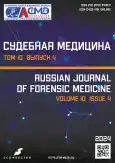基于X线摄影法确定长管状骨干骨折的时间
- 作者: Li Y.B.1,2, Vishniakova M.V.1,3, Maksimov A.V.1,4
-
隶属关系:
- Moscow Regional Research and Clinical Institute
- Primorsky Regional Bureau of Forensic Medicine
- A.V. Vishnevsky National Medical Research Center of Surgery
- State University of Education
- 期: 卷 10, 编号 4 (2024)
- 页面: 498-508
- 栏目: 原创研究
- URL: https://journal-vniispk.ru/2411-8729/article/view/288319
- DOI: https://doi.org/10.17816/fm16172
- ID: 288319
如何引用文章
全文:
详细
背景。骨骼损伤的研究是法医专家在活体鉴定工作中的核心内容之一。在犯罪案件中,肇事者可能隐瞒事件发生的具体情况和时间,或受害者延迟就医的情况下,确定骨折时间可能成为一项挑战。在这种情况下,受损骨骼的X线摄影结果是重要的信息来源。
研究目的。通过X线影像分析,确定长管状骨骨干部骨折在特定愈合阶段的影像学特征。
材料与方法。对192份X线片(包括初次和随访动态观察X线片)进行了回顾性研究。研究对象为20至80岁的男性和女性(n=56),其长管状骨发生骨折,部分进行了金属内固定术。研究依次分析了不同愈合阶段骨折的X线影像变化,描述了主要形态学特征,并对其进行系统分析、组间比较和结构化总结。
结果。确定了骨折愈合的明确时间段,识别了跟踪愈合动态的主要影像学特征,描述了骨折愈合过程中的形态学变化。未发现性别对愈合速度的显著影响。手术(如金属内固定术)对愈合速度无显著作用。
结论。长管状骨干骨折的X线影像表现具有特定的形态学特征,并随骨折发生时间的不同而变化。
作者简介
Yulia B. Li
Moscow Regional Research and Clinical Institute; Primorsky Regional Bureau of Forensic Medicine
编辑信件的主要联系方式.
Email: reineerdeluft@gmail.com
ORCID iD: 0000-0001-7870-5746
SPIN 代码: 2397-7425
俄罗斯联邦, Moscow; Vladivostok
Marina V. Vishniakova
Moscow Regional Research and Clinical Institute; A.V. Vishnevsky National Medical Research Center of Surgery
Email: cherridra@mail.ru
ORCID iD: 0000-0003-3838-636X
SPIN 代码: 1137-2991
MD, Dr. Sci. (Medicine)
俄罗斯联邦, Moscow; MoscowAleksandr V. Maksimov
Moscow Regional Research and Clinical Institute; State University of Education
Email: mcsim2002@mail.ru
ORCID iD: 0000-0003-1936-4448
SPIN 代码: 3134-8457
MD, Dr. Sci. (Medicine), Professor
俄罗斯联邦, Moscow; Moscow参考
- Ilyasova EB, Chekhonatskaya ML, Priezhev VN. Radiation diagnostics. 2nd ed. Moscow: GEOTAR-Media; 2021. 432 р. (In Russ.)
- Lindenbraten LD, Korolyuk IP. Medical radiology (basics of radiation diagnostics and radiation therapy): textbook. 2nd ed., revised and updated. Moscow: Meditsina; 2000. 670 р. (Series: Textbook for medical students). (In Russ.) EDN: YMMUAH
- Klyuchevskiy VV, Litvinov II. Practical traumatology. Manual for doctors. Moscow: Prakticheskaya meditsina; 2020. 400 р. (In Russ.) EDN: LRGSYK
- Hempe S, Bieler D, Braunegger G, et al. [Extracorporeal shockwave therapy as an alternative treatment in cases of posttraumatic delayed bone union. (In German)]. Unfallchirurgie (Heidelb). 2023;126(10):779–787. doi: 10.1007/s00113-022-01225-5
- Russow G, Heyland M, Märdian S, Duda G. Knochenbruchheilung und klinische belastungsstabilität. OP-Journal. 2019;35(01). doi: 10.1055/a-0755-6202
- Fischer C. [Diagnostics and classification of non-unions. (In German)]. Unfallchirurg. 2020;123(9):671–678. doi: 10.1007/s00113-020-00844-0
- Grossner T, Schmidmaier G. [Conservative treatment options for non-unions. (In German)]. Unfallchirurg. 2020;123(9):705–710. doi: 10.1007/s00113-020-00851-1
- Entezari A, Swain MV, Gooding JJ, et al. A modular design strategy to integrate mechanotransduction concepts in scaffold-based bone tissue engineering. Acta Biomater. 2020;118:100–112. doi: 10.1016/j.actbio.2020.10.012
- Gould NR, Torre OM, Leser JM, Stains JP. The cytoskeleton and connected elements in bone cell mechano-transduction. Bone. 2021;149:115971. doi: 10.1016/j.bone.2021.115971
- Belokonev VI, Pushkin SYu, Ardashkin AP, et al. Dynamics of morphological changes in fracture sites in victims with thoracic trauma and flail chest. Science and innovations in medicine. 2018;(4):6–12. EDN: POCNJV
- Zavadovskaya VD, Popov VP, Akbasheva OE, et al. Ultrasound monitoring of consolidation processes in fractures of long tubular bones in osteosynthesis using bioactive implants. J Radiology Nuclear Medicine. 2014;(5):40–48. EDN: TBCPJX doi: 10.20862/0042-4676-2014-0-5-40-48
- Kireeva EA. Forensic-medical determination of the age of rib fractures [dissertation abstract]: 14.00.24. Place of defence: Russian Centre of Forensic Medical Examination. Moscow; 2008. 21 р. (In Russ.)
- Li YuB, Vishniakova MV, Klevno VA. Forensic significance of X-ray data in the definition prescription of diaphyseal fractures: A case from expert practice. Russ J Forensic Medicine. 2022;8(2):65–71. EDN: GCWJGS doi: 10.17816/fm711
- Li YuB, Vishniakova MV, Maksimov AV. Forensic medical determination of the age of fractures based on X-ray research methods: A literature review. Russ J Forensic Medicine. 2024;10(2):229–240. EDN: ACRUSV doi: 10.17816/fm16085
- Reiser M, Baur-Melnik A, Glaser K. Direct diagnosis in Radiology. Musculoskeletal imaging. Ed. by N.B. Petrova. Transl. from English by V.A. Klimov. Moscow: MEDpress-Inform; 2011. 384 р. (In Russ.)
- Reinberg SA. Radiodiagnostics of diseases of bones and joints. In 2 books. 4th, revised and updated. Moscow: Meditsina; 1964. (In Russ.)
- Romanov PG, Devyaterikov AA, Shtempelyuk YR. Problems of forensic medical evaluation of nasal bone fractures. In: Selected issues of forensic medical expertise: A collection of articles. Ed. by A.I. Avdeev, I.V. Vlasiuk. Vol. 21. Khabarovsk: Far-Eastern State Medical University; 2022. Р. 103–105. (In Russ.) EDN: COZRPM
补充文件











